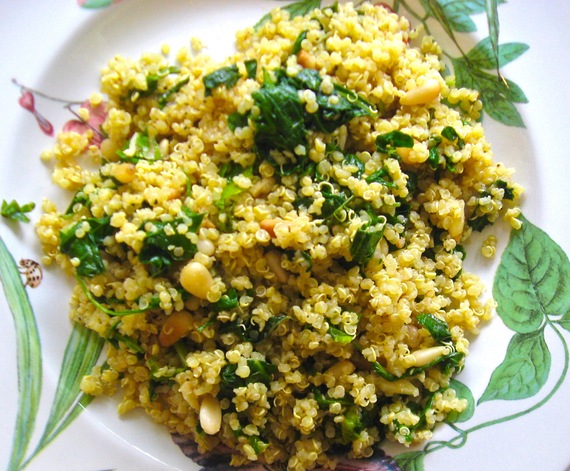With Passover beginning last week, I've been thinking about the intersection of vegan and kosher. Seems like they'd be good friends. Being vegan means there's no risk of mixing meat and dairy, since neither are on the table. But it turns out what is vegan is not always by-the-book kosher. Like veganism, kashrut or traditional Jewish dietary law, has at its core tenet compassion or tza'ar ba'alei chayim -- humane animal treatment under Jewish law. Keeping kosher, you think you're doing right by animals, but as Rabbi Adam Frank realized, there's nothing right about how farmed animals are raised or killed. After attending a 2003 animal rights conference and learning about supposedly humane kosher slaughter, he says, "I became vegan on the spot."
Frank, who serves as rabbi at conservative Moreshet Yisrael synagogue in Jerusalem, grew up in Atlanta. He and his three brothers had little sense of Judaism, let alone veganism. Then their parents, who'd been largely unobservant, decided to keep kosher at home as "a vehicle to strengthen our Jewish identity." As Frank grew older, he grew more devout. He attended Jewish day school, and at home, keeping kosher felt right. "It was a way of expressing the Jewish values of concern for animals, of being in a relationship with God," he says. "It was an important part of how I defined myself as a Jew in the world."
Frank became an ordained rabbi in 1999 and moved to Israel in 2001. While his faith has deepened, experience has sometimes led him to question aspects of it, particularly in terms of animal welfare. As both a vegan and a Jewish leader, he's studied Torah and worked to "understand how rabbinic leaders and arbiters of Jewish law allow such mistreatment and cruelty to occur," says Frank. "The issue has become the one area of expertise in my role as teacher of Torah." It is one thing to study it, it's another to come to terms with what he calls the "dissonance between what I understand to be Jewish laws and ideals and the realities of these industries. Killing animals for food is morally problematic," says Frank.
Along with Mayim Bialik, author of the new book "Mayim's Vegan Table," he's affiliated with the kosher vegan advocacy group Shamayim V'Aretz Institute, founded by director Schmuly Yanklowitz. "He and I share the belief that the ideal Jewish diet is one that incorporates a compassionate approach to animals," says Frank. "We cannot hope to be a light to other nations until we start to reach our own potentials for living a life that expresses justice, caring and concern for others in all facets of our life."
The rabbi continues to "educate and sensitize the Jewish world to the problems that escort animal-based foods and to elicit a change of people's behavior." Tonight, though, Frank, his wife and three children will observe Passover with a kosher vegan seder. A drawing of a bone "like a dog's Milkbone" is the symbolic stand-in for the seder plate's traditional lamb shank. "My eating choices reflect my values system."
Being a rabbi, he says,"is a calling, not a job." And being vegan has "given me greater patience and greater passion for the work I do."
Quinoa With Mint Pesto and Spring GreensAlthough kosher and vegan aren't always the same thing, Rabbi Frank and his family are happily both. Now is the only time it's a challenge "because of the vastly limited vegan fare that is kosher for Passover," he says. Quinoa saves the day in this bright, springy and kosher for Passover main course salad.
1-1/2 cups quinoa, rinsed*
3 cups water or vegetable broth
1 cup cilantro leaves
1 cup mint leaves
1 clove garlic
1/4 cup walnuts
1/2 cup olive oil
2 tablespoons lemon juice
sea salt and freshly ground pepper to taste
4 stalks celery with leaves, chopped
1 bunch arugula
1 bunch spinachBring vegetable broth or water to boil in a medium saucepan. Add quinoa. Cover, reduce heat to low and simmer for 20 minutes, or until the quinoa has absorbed all the liquid and has sprung their little endosperm tails. Fluff with a fork and set aside to cool.
In a food processor, briefly pulse cilantro, mint, garlic and walnuts till they form a great, green paste.
Drizzle in olive oil in a slow, steady stream. Add lemon juice and sea salt and pepper to taste.
Toss quinoa with 3 tablespoons of mint pesto. Reserve the remaining pesto (it keeps covered and refrigerated for several days). Quinoa may be made a day ahead at this point and kept covered and refrigerated. Remove from the refrigerator 1 hour before serving, to bring out best flavor.
Just before serving, toss quinoa with chopped celery, arugula and spinach. Add another dollop or two of pesto, if desired.
Serves 6. Doubles easily.
*Rinsing rids the quinoa of saponins, the ancient grain's natural, protective bitter coating.
The original version of this post first ran April 14, 2014.
More at soulfulvegan.com

